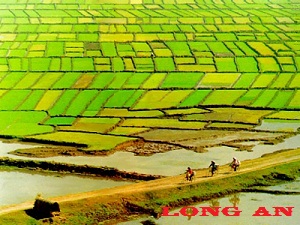- Vietnam Overview
- Main Cities in Vietnam
- Regions in Vietnam
- Other Cities in Vietnam
- Getting to Vietnam
- Getting Around Vietnam
- Language in Vietnam
- Education in Vietnam
- Vietnam Activities
- Vietnam Attractions
- Vietnam Money & Shopping
- Eating and Drinking in Vietnam
- Dress Code in Vietnam
- Gift Giving in Vietnam
- Public Behavior in Vietnam
- Art Performance
- Custom and Habits
Long An Province
Long An preserves valuable sites including House with Hundred Columns, Rach Coc Fort, Ton Thanh Pagoda. In Dong Thap Muoi Eco-tourist Site, tourists can discover many special flora and fauna and try typical dishes of the South.
Geography
Located on the Mekong Delta, Long An is surrounded by Tay Ninh Province and Cambodia on the north, Ho Chi Minh City on east, Tien Giang Province on the south and Dong Thap Province on the west.
Long An is divided into smaller areas by a complex network of rives and canals. Silt from Vam Co Dong and Vam Co Tay rives has raised the level of the field of Long An. This silt makes a good condition for agriculture. The terrain is quite flat except some hills and mounds on the north. The western area belongs to the Plain of Reeds.
Climate: Long An is on tropical monsoon climate. The rain season lasts from May to October and the dry season lasts from November to April next year. Annual average temperature is 27.4ºC. Annual average rainfall is 1,620mm.
The province comprises one town (Tân An, the provincial capital) and 14 districts:

- Bến Lức
- Cần Đước
- Cần Giuộc
- Châu Thành
- Đức Hòa
- Đức Huệ
- Mộc Hóa
- Tân Hưng
- Tân Thạnh
- Tân Trụ
- Thạnh Hóa
- Thủ Thừa
- TX Tân An
- Vĩnh Hưng
Tourism
Visitors are attracted to Long An by value of Oc Eo culture that develops on the Mekong Delta from 1st BC to 6th century BC. 12,000 objects of 20 prehistoric monuments and 100 Oc Eo culture relics have been found. Beside these, Long An preserves valuable sites including House with Hundred Columns, Rach Coc Fort, Ton Thanh Pagoda. In Dong Thap Muoi Eco-tourist Site, tourists can discover many special flora and fauna and try typical dishes of the South.

